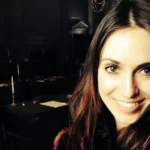EDISON AWARDS – Innovations and Innovators
BY ELIZABETH DILTS AND KRISTIE CERUTI
THE BEAUTY OF DENTISTRY lies not just in the healing of pain and repair of the body, nor in the aesthetic boost of an orthodontic or cosmetic procedure, as vital as those all are. An often overlooked component is the sheer invention and innovation that are hallmarks of our profession and that help make dentistry not just a staid discipline but a vital industry in a headlong rush to the future.
For the third year running, Incisal Edge has partnered with the Edison Awards to honor the top products and most impressive advances dentistry has seen in the last year. In truth, though, this sort of thing has been going on forever. We impassioned consumers of smartphone and wireless technology can sometimes be forgiven for thinking that innovation itself was invented only yesterday, but the sheer ingenuity that is the calling card of the Edison Awards goes back eons.
Such ingenuity got a decided lift during the lifetime of Thomas Alva Edison, the awards’ namesake, and it continues to loom large today in the sound instincts and impressive brains of dental innovators such as Dr. Paul Zhivago (right), whose Open Platform Workflow system uses filmmaking technology to vastly improve the quality of digital impressions of patients’ mouths.
No matter what the industry circumstance, though, dentistry will never — could never — stand still, remaining in place and making no progress. The thrum of medical advance is simply too strong. Yet the bright minds and beautiful products on the pages that follow truly represent the pinnacle of our profession at the present moment. They carry on the spirit and legacy of Thomas Edison — and provide a useful benchmark for generations of dental innovators still to come.
“If we did all the things we are capable of, we would astound ourselves.”
—Thomas Edison
ABOUT THE EDISON AWARDS
SINCE 1987, the Edison Awards have recognized and honored some of the most innovative new products, services and business leaders in the world. The Awards are named for Thomas Alva Edison (1847–1931), whose extraordinary new product- and market-development methods garnered him 1,093 patents and made him a household name around the world. The Edison Awards symbolize the persistence and excellence personified by Edison himself, while also strengthening the human drive for innovation, creativity and ingenuity.
3M MOBILE TRUE DEFINITION SCANNER
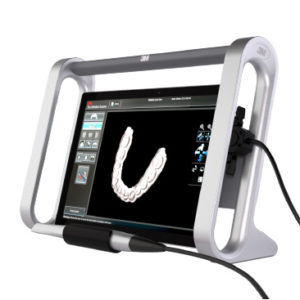
THIS MAGAZINE HAS featured 3M’s True Definition Scanner and its primary developer, Todd Deckard, previously. This latest iteration of its pioneering 3D scanner, however, is truly, unprecedentedly mobile. There’s no 75-pound cart to drag around, just a 1.5-pound tablet. Using the scanner’s small wand, a dentist can capture a three-dimensional impression of a patient’s mouth, view it on the tablet and upload it to 3M’s cloud-based Connection Center to send to a lab. Because the entire device consists of a handheld wand and tablet, dentists can tote it from room to room without cart or cords. Even better, they can have more-informed, productive conversations with patients by putting the tablet directly into their hands. Deckard calls it “a device you want to hold, which captures information you want to share. [It] delivers the technology in a form that fits your hand, fits your practice and fits your budget.”
NUPRO FREEDOM CORDLESS PROPHY SYSTEM WITH SMARTMODE TECHNOLOGY BY DENTSPLY SIRONA
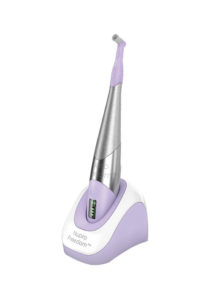
AGES: Lint 54, Fayer 59, Michel 52
EDUCATION: Lint (above): master’s in electrical engineering, Pennsylvania State University; Fayer: bachelor’s in electrical engineering, Marquette; Michel: bachelor’s in electrical engineering, Western Institute of Technology and Higher Education, Jalisco, Mexico
DENTISTS AND HYGIENISTS work with their hands, so why have the lot of us been controlling polishers with our feet all this time? The Nupro Freedom Cordless Prophy System with “SmartMode” technology eliminates that pesky foot pedal, saving valuable floor space and eliminating movement that can, over time, stress a clinician’s back and wrists. The prophy handpiece is controlled by the exer- tion you apply to the patient’s tooth. When you start polishing, it spins at 500 RPM; as you add pressure, the speed increases to a maximum of six times that. Reduce pressure and that SmartMode tech slows the speed. “When the hygienist polishes, he or she typically presses harder or pushes the foot pedal to increase the speed,” says Kevin Lint, director of research and development for Dentsply Sirona, who led the device’s three-man development team. “By combining these two actions, we have eliminated the foot pedal.”
OPEN PLATFORM WORKFLOW IN DIGITAL DENTISTRY
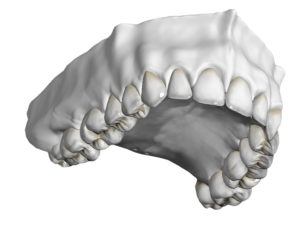
AGE: 39
EDUCATION: DDS, New York University College of Dentistry
PAUL ZHIVAGO HAS more in common with the Russian protagonist of Boris Pasternak’s acclaimed 1957 novel than name and title alone. The fictional Dr. Zhivago was a physician and poet; this one is a prosthodontist and painter who has invented a tool to bridge his scientific and artistic sides in a way Pasternak’s doctor could scarcely have imagined.
Dr. Zhivago’s Open Platform Workflow employs a software program originally used by filmmakers to sculpt digital impressions of patients’ mouths. “In dental school, when I had to study anatomy, I’d draw the tooth in 3D software,” he says. This method helped him remember the lesson better, like digital flashcards.
As he advanced in the profession, he looked for more intuitive software that would enable him to improve the art of his craft. “You cannot explain to a software program why this shape is more beautiful than that one,” he says. But dentists who use his pen, his 22-inch touch-screen monitor and the overall platform of the “Zbrush” software he developed will have no such trouble as they sculpt images as lifelike and attractive as their patients’ teeth.
430 TORQUE HIGH-SPEED HANDPIECE BY DENTALEZ
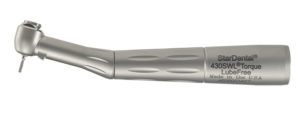
AGES: (Above, from left) Pennington 57, Gates 35, Cahill 44, Laskowitz 33
EDUCATION: Laskowitz: bachelor’s in mechanical engineering, University of Maryland; Gates: bachelor’s in mechanical engineering, Pennsylvania state University; Cahill: associate’s degree, American Institute of Design; Pennington: 39 years at DentalEZ
MORE OOMPH IN THE same package: That could well be the tagline for the 430 Torque, the high-speed handpiece developed by this quartet of inventors at DentalEZ. Over its 100 years in the industry, the company has built a reputation for crafting the drill with the smallest possible head. How small? The 430 Torque’s noggin is just 11.1 millimeters across, or slightly bigger than the cap of a ballpoint pen.
That slender profile — about 10 percent smaller than the drill of DentalEZ’s nearest competitor — gives dentists the greatest visibility. “The oral cavity is a very small, dark space,” says senior product manager Aggie Pennington. “You want to keep the head as small as possible to allow the dentist to see.” The torque of DentalEZ’s old air-powered model, though, couldn’t compete with that of electric drills. The foursome worked through an equal number of prototypes over two years before they struck the right balance: a drill that spins at 395,000 revolutions per minute with 27 watts of power.
“A rock pile ceases to be a rock pile the moment a man contemplates it, bearing within him the image of a cathedral.” —Antoine de Saint-Exupéry
CS 3600 INTRAORAL SCANNER BY CARESTREAM DENTAL
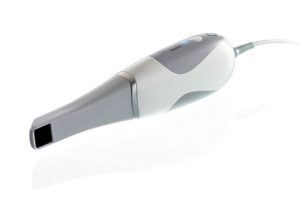
AGE: 55
EDUCATION: DMD, Case Western Reserve University School of Dental Medicine; MBA, Pepperdine University
WHAT HAS THE digital age taught us about human nature? Whatever the technology, we want it to work faster. That’s the hallmark of Carestream’s latest version of its top 3D scanner. With faster image capture, the portable, trolley-free CS 3600 both saves time and boosts accuracy. It’s continuously taking pictures, making dual arch scans fast while keeping individual file sizes small enough to transfer to a computer via USB stick. “With intraoral image capturing, it’s all about managing data once you’ve captured it,” says the CS 3600’s inventor, Dr. Edward Shellard, formerly a dentist in New York. In his device, color scans create high-definition three-dimensional pictures of the inside of the mouth that can be used for orthodontic, restorative or implant cases.
STERISIL SYSTEM G5
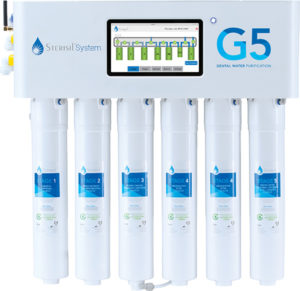
AGE: 37
EDUCATION: Bachelor’s in biological engineering, master’s in chemical engineering, University of Florida
WHETHER YOU NEED a dental water-line cleaning system for dozens of chairs or just one, this Sterisil product (plus the Sterisil Straw, opposite page) breaks new ground when it comes to disinfection. The Sterisil System G5 uses smart technology and a touch screen to display intuitive color signals indicating when it needs maintenance: green is good, yellow is a warning, red means stop using and replace one or more cartridges immediately. “This machine tells [a dentist] exactly how to maintain itself with clarity and convenience” — something users said they had struggled with, says Langston McDowell, a Sterisil technical director. At a cost of $12,000 to $15,000, the Sterisil System is an investment, but it can treat water lines for up to 200 operatory chairs. “It’s like the difference between an old car and a new Cadillac,” McDowell enthuses. “It’s an infection-control experience.”
STERISIL STRAW V2

AGE: 37
EDUCATION: Bachelor’s in biological engineering, master’s in chemical engineering, University of Florida
UNLIKE ITS SYSTEM G5 brother (see preceding page), the Sterisil Straw V2 is meant for just one chair, and its disinfection system is so straightforward it’s nearly “dummy-proof,” inventor Langston McDowell says. The straw’s cartridge twists onto the pickup tube with a Luer Lock fitting. Earlier versions required sheer brute strength to attach the straw to the line, a source of considerable user complaint. This model, McDowell says, can be fully attached in under a minute. “The Luer Lock assembly is everything, because it eliminates uncertainty,” he says. It also ends about a quarter-inch from the bottom of the bottle, thereby preventing clogging in the tube. The straw comes in two separate versions — one for distilled water, the other for municipal — and will last up to a year.
“The principal mark of genius is the opening of new frontiers.” —Arthur Koestler
GLOSCIENCE ECO BALANCE
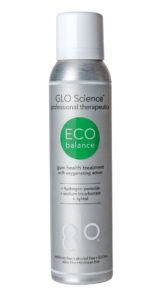
EDUCATION: Bachelor’s in microbiology, Cornell; DMD, Boston University; board certification in prosthodontics, New York University
GLOBALLY, POOR GUM HEALTH is a problem of vexing proportions. Combat it, and you’ve made great strides in tackling a host of other ailments. Here to assist is Eco Balance from GloScience, a simple volumizing gel that raises the pH level of the oral cavity and oxygenates the bacteria that can cause inflammation therein. Used with a proprietary mouthpiece kit or even just atop one’s everyday toothpaste, the gel expands into a foam that penetrates all those pesky areas around the gum line, battling a host of problems that even diligent brushers and flossers often have trouble with. GloScience founder Dr. Jonathan B. Levine, who developed Eco Balance, had a lightbulb moment when he learned that subjects in a GloScience whitening-device study weren’t just getting flashier teeth — their gingivitis was clearing up as well. A little tinkering with the particulars, and Eco Blance was born. “It’s easy for patients to use as part of their regular oral-care routine,” Dr. Levine says. “With one of every two adults in the U.S. having periodontal disease, and 70 percent with gingivitis, coupled with the knowledge of the connection between periodontal disease and inflammatory diseases in the body, there’s very good reason to control inflammation in the mouth.” With Eco Balance, that crucial task just got easier
MAXCEM ELITE CHROMA BY KERR CORPORATION
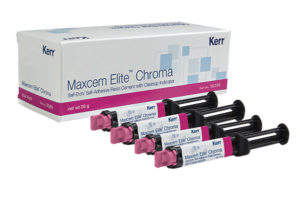
AGE: 53
EDUCATION: Master’s and Ph.D. in polymer science, Case Western Reserve University
WHEN YOU’RE cementing a crown to a patient’s tooth, every second counts. That little bit of cement that oozes out from the crown bonding onto the tooth exterior? You know the (pardon the pun) drill: Clean it off too early and it can disturb the bond. Do so too late and it’ll harden. What, though, if you could get a visual cue at the precise moment the cement is ready to remove? That’s what Eugene Qian, director of product development at Kerr, has accomplished with Maxcem Elite Chroma, the first self-adhesive resin cement that changes color (from pink to white) when it’s ready for the brush-off. Time it right, and removal is like a hot scalpel through butter. “It translates into confidence in patient comfort, predictability and ease,” Qian says. “The cement almost talks to you and tells you it’s time to clean.”
ORTHO VISION PLATFORM BY ORTHO CLINICAL DIAGNOSTICS
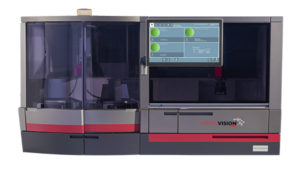
That’s where Ortho Vision comes in. Over its 78-year history, Ortho Clinical Diagnostics has created devices used in hospitals, blood banks and laboratories to test patients’ blood and detect heart problems, HIV, prostate cancer and more. The company’s tools help complete an incremental but critical step along the path of diagnosis and treatment.
The Ortho Vision Platform comprises two automated blood analyzers: Ortho Vision and Ortho Vision Max. The former accommodates smaller numbers of tests; the latter can handle up to 50 types and screens per day. Intended primarily for use in transfusion-medicine laboratories, the Ortho Vision Platform devices will be increasingly important as dental clinicians and oral surgeons work more closely with patients’ full medical team to detect and treat ailments of all kinds.
PROMETHEUS COUPLER BY JOHNSON- PROMIDENT
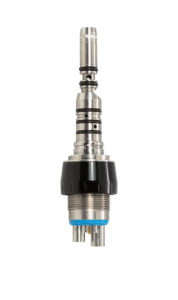
AGE: 47
EDUCATION: MBA, the University of Pennsylvania Wharton School of Business
DENTAL DRILLS and bicycles might not seem to have much in common. Yet Johnson-Promident marketing manager Gary Kris experienced his eureka moment — the holy grail of inventors throughout the ages — while pondering a way to make a bike’s pedals power a rider’s visibility light.
Behold the Prometheus Coupler, an inch-long canister that attaches to a dentist’s handpiece and converts the drill’s exhaust air into electricity to power an LED situated at the tip of the tool. Named for the Greek titan who stole fire from the gods to give to man, Prometheus is perhaps the biggest innovation, Kris posits, in Johnson- Promident’s 45 years.
For decades, the company made and sold fiber-optic systems — drill lights powered by electric cables running from the handpiece through the operatory chair, over the floor to a wall transformer. The cables naturally took a beating, but at an upfront cost as high as $1,300, many dentists forwent fixes because they were simply too pricey. That’s no longer a problem: “[The Prometheus Coupler] is small, it weighs an ounce and it can be moved from chair to chair,” Kris says. “It replaces a fiber-optic system.”
EDUCAM BY FUTUDENT
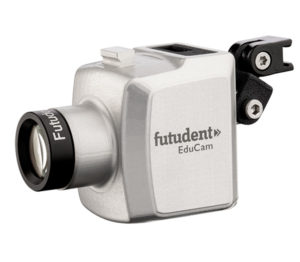
AGES: (Above, from left) Rusanen 41, Kahre 42, Forth 42
EDUCATION: Rusanen: dental degree, University of Helsinki Institute of Dentistry, Finland; Kahre: master’s, Hanken School of Economics, Helsinki; Forth: bachelor’s, Trent University, Peterborough, Ontario
VIDEO, YOU HAVE perhaps noticed, is pretty much everywhere. It was less so eight years ago, though, when Finland-based prosthodontist Peter Rusanen was working to build a camera that could capture the precise perspective a dentist has into a patient’s mouth.
Enter entrepreneur Lars Kahre, a video specialist at the University of Helsinki. He and Rusanen developed the Educam, a small, sturdy HD camera that can attach to a loupe, chair light, headband or tablet to secure the optimal angle. Dentists can use it to share clear footage of a patient’s oral cavity with a specialist, students or patients themselves, then store the clip on a secure cloud-based platform for easy access.
It’ll shoot sharp footage whether it’s close to or far from the patient. “You’re getting inside the mouth, but virtually,” says Brian Forth, who has partnered with the Finnish duo to bring Educam, which costs around $1,900, to the U.S. market. High-quality video, Forth predicts, will be the next big step forward in dental communication — and Educam plans to lead the way.
EVEREDGE 2.0 SCALERS/CURETTES BY HU-FRIEDY
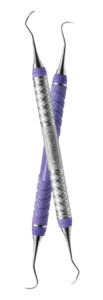
AGES: Platt 47, Tipton 47, Schenk 39
EDUCATION: Platt: master’s in engineering management, Northwestern University; Tipton: bachelor’s, Bradley University; Schenk: engineering education during six years as active-duty Marine
AS A SURGEON relies on her scalpel, so too a dentist his scaler — which needs to be sharp, hard and resilient. Hu-Friedy’s latest certainly fills those needs.
David Platt, David Tipton and Al Schenk spent three years testing more than 10 kinds of steel before they selected a type often used in high-end cutlery. They developed a proprietary process for hardening the steel to reach maximum performance, and worked with “edge retention” experts in England to develop a blade that retains its sharpness but can be resharpened if needed. “EverEdge 2.0 is a differentiator in the history of dental scalers because it stays sharper longer,” Platt says. “We used a third party that started testing knives to test our products against our competitors’, and the proprietary steel-hardening process is our secret sauce.
“Creativity is a continual surprise.” —Ray Bradbury
TROLLBYTE RAYZOR FOR DEXIS SENSORS BY TROLLDENTAL USA
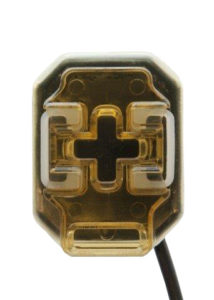
AGE: 59
EDUCATION: Master’s in machinery, Chalmers University of Technology, Sweden
EVER PULLED UP to a gas pump on the wrong side, then wondered why on earth the auto industry can’t just pick an industry standard for such a common thing? TrollDental owner Jan Westerlund wondered something similar about the sensors and holders dentists use to take digital images of teeth. There’s no standard, and a dentist must use several holders depending on where in the mouth the sensor goes.
Westerlund’s invention, the TrollByte Rayzor, is one simple holder that works for all Dexis sensors and can be placed in any part of the mouth to take quick, precise images in a manner that’s comfortable for the patient. “If a dentist makes his procedure faster, he will be happier and have less stress,” says Westerlund, whose wife is a dentist. “That is the key for us.”
“All good work requires self-revelation.” —Sidney Lumet
VACUCLEAR WITH INVIZIO-GUARD KIT BY TRICOM DENTAL PRODUCTS
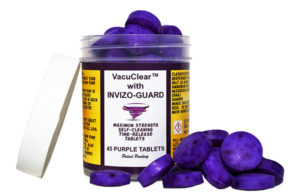
AGE: 51
EDUCATION: Ph.D. in chemical engineering, the University of Tel Aviv
WITH APOLOGIES TO pond scum and raw sewage, biofilm might be the least alluring material on earth. But the slimy result of saliva, bone fragments, blood and other matter that gets sucked out of patients’ mouths and into water lines isn’t just gross — it can be downright dangerous.
The federal Centers for Disease Control recommends that dental practices flush their water lines at the start of each day, and flush devices used in patients’ mouths after each individual visit. But Howard Michael Cantor, a Colorado-based chemical engineer who invented the VacuClear system, says even that might not be enough to prevent a “breeding ground for new disease.”
VacuClear is the first self-cleaning system that sterilizes evacuation lines throughout the day, while patients are being treated. It works by neutralizing contaminants at the source and sending cleaning agents throughout the entire network of evacuation lines, both PVC and copper.
The separate Invizio-Guard, meanwhile, coats tubes with a thin protective shield that keeps biofilm, hard water and fluoride deposits from collecting in the tubes. Nontoxic, non-foaming and non-corrosive, VacuClear eliminates some 99.9 percent of germs, Cantor says, and will almost completely unclog dental water lines.
STERLING HIGH-SPEED FIBER-OPTIC HANDPIECES BY J. MORITA USA FOR BENCO DENTAL
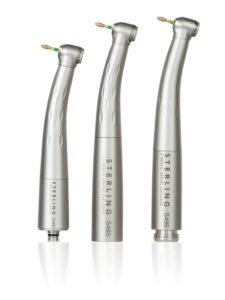
AGES: (Left, from top) Jikuhara 47, Takashi 42, Nakayama 67
EDUCATION: Takashi: degree in mechanical and systems engineering, Kyoto Institute of Technology; Nakayama: graduate degree in engineering, Kyoto University; Jikuhara: degree from the National Institute of Technology’s Maizuru College, all in Japan
THE TRUE TEST of a handpiece is its staying power — or, more pertinently, how much power it can maintain while the dentist is drilling. Some handpieces shed as much as half of their torque when burr meets tooth; the Sterling High-Speed loses less than 4 percent, meaning it’ll maintain 22 watts of torque consistently, whatever the procedure. The tool is even more powerful thanks to its two layers of turbines and two rows of air pressure, a structure that took an astonishing 220 engineers more than six years to develop. “A double-impeller structure generates super cutting power with a considerably small head size,” says Hirofumi Jikuhara, one of the project’s lead engineers. “Compare that power and head size to any other dental-turbine handpiece.” Sterling’s machine also wins points for cleanliness: Its air systems don’t draw back any saliva or blood from the patient’s mouth the way many handpieces do. Says co-engineer Tetsuya Takashi: “It’s a one-of-a-kind feature to effectively prevent nosocomial infections at the clinic.”
THROAT SCOPE
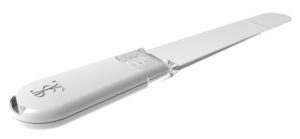
AGE: 34
EDUCATION: Bachelor’s in business, Charles Sturt University, Australia
WHAT BEGAN AS a trip to the emergency room for an allergic reaction in her daughter turned into Jennifer Holland’s zillion-dollar idea. The Australian mother of four had observed a dozen pediatricians over the years struggle to hold both tongue depressor and light when examining the throat of a squirmy little kid. Why not attach the light to the tongue depressor? Her first prototype was an LED taped to a piece of polycarbonate plastic, and she has come a long way since then. After an appearance on Australia’s version of Shark Tank, the business-pitch TV show, the clear plastic device with a built-in light won the support of multimillionaire entrepreneur Steve Baxter. Holland’s company is now valued at some $7 million, and Throat Scope was recently endorsed by the U.S. Oral Cancer Foundation; the organization will use Holland’s device at all of its cancer-screening clinics nationwide. “I always had it in me that I wanted to do something different,” Holland says. “But it wasn’t until something directly affected my children that I wanted to give it a shot.”



